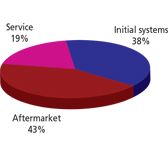Amino Acid Analyzers
The techniques involved in successfully separating and quantifying amino acids vary from instrument to instrument. However, the processes for amino acid analysis are similar, involving hydrolysis, labeling, separation, and detection followed by data analysis.
The techniques involved in successfully separating and quantifying amino acids vary from instrument to instrument. However, the processes for amino acid analysis are similar, involving hydrolysis, labeling, separation, and detection followed by data analysis.
In the traditional method for breaking down proteins for amino acid analysis, the protein or peptide sample is first hydrolyzed in a vacuum or inert atmosphere. A gradient of buffers elutes the sample, which then passes through a resin-packed ion-exchange column. The ninhydrin reagent is applied, turning the primary amino acids a bluish color and the secondary amino acids brownish-yellow.

2006 extraction technique product type.
The ramifications of this automated technique, which was first pioneered by Nobel laureates Stanford Moore and William Stein in 1958, have influenced research in areas such as nutritional analysis of animal feed, quality control of pharmaceuticals, and detection of amino acid deficiency disorders.
Amino acid analyzers are used for maintaining high manufacturing standards in the food industry. By testing specific amino acid profiles in fruit juice, for instance, scientists are able to determine not only the origin of the fruit and the conditions in which it was processed, but also the climate in which the fruit grew and how ripe it was when squeezed.
In dairy products, analyzers can detect the presence of unwelcome protein compounds, and, as a result, verify the purity and freshness of a batch of milk. A thorough amino acid analysis also can guarantee the safety of products that are particularly susceptible to contamination and for products from which consumers demand the highest degree of reliability, such as baby formula.
Growth for the AAA market is expected to be moderate and reach nearly $100 million by 2011. This growth is fueled by replacements of legacy systems and continued growth from the food and beverage industry. However, alternative methods like capillary electrophoresis and mass spectrometry techniques are also impacting its growth.
The foregoing data was extracted and adapted from SDi's Market Analysis and Perspective: High Performance Liquid Chromatography. For more information, contact Glenn Cudiamat, VP of Research Services, Strategic Directions International, Inc., 6242 Westchester Parkway, Suite 100, Los Angeles, CA 90045, (310) 641-4982, fax: (310) 641-8851, e-mail: cudiamat@strategic-directions.com

New Study Reviews Chromatography Methods for Flavonoid Analysis
April 21st 2025Flavonoids are widely used metabolites that carry out various functions in different industries, such as food and cosmetics. Detecting, separating, and quantifying them in fruit species can be a complicated process.
Analytical Challenges in Measuring Migration from Food Contact Materials
November 2nd 2015Food contact materials contain low molecular weight additives and processing aids which can migrate into foods leading to trace levels of contamination. Food safety is ensured through regulations, comprising compositional controls and migration limits, which present a significant analytical challenge to the food industry to ensure compliance and demonstrate due diligence. Of the various analytical approaches, LC-MS/MS has proved to be an essential tool in monitoring migration of target compounds into foods, and more sophisticated approaches such as LC-high resolution MS (Orbitrap) are being increasingly used for untargeted analysis to monitor non-intentionally added substances. This podcast will provide an overview to this area, illustrated with various applications showing current approaches being employed.

.png&w=3840&q=75)

.png&w=3840&q=75)



.png&w=3840&q=75)



.png&w=3840&q=75)







